I was all set to talk about buying and selling power this week. Then late Tuesday night I was sent a link to this post on the Polish Tamales blog. It contains pictures of fake Magic cards from China that are nearly indistinguishable from the real thing.
This is a very big deal. Some people are calling it "the end of the game as we know it." Indeed, it bears a striking resemblance to something I "predicted" in World War M, the fictional article I wrote in 2012 about what it would take to kill Magic. In the article, a glut of too-good-to-be-true counterfeits flooded the market on January 13th, 2014.
That is the very same date that this article will be published on StarCityGames.com.
Before devolving into doomsday predictions, though, let’s take a deep breath and remember just how resilient this game truly is. The worst-case counterfeiting scenario might be bad, but it will not kill Magic. You do not need to panic sell your entire collection. You do not need to stop buying and trading for cards. It’s important to retain perspective and keep calm.
With that out of the way, let’s explore the counterfeiting issue in two parts. The first will cover what’s going on right now, while the second will cover what may happen in the future if things do get worse.
What We Know
As always, let’s start with what we know.
There is at least one website where you could order high-quality counterfeit Magic cards from China as recently as last Thursday
The site is not hard to find. There are images going around the Internet right now that have the URL plastered all over it. As of last Thursday, the website was not even trying to hide what it was doing. The company was bragging about producing counterfeit Magic cards, claiming them to be their hottest-selling product.
The below screenshot was taken last week. Note the prominent placement of Magic cards on the site:
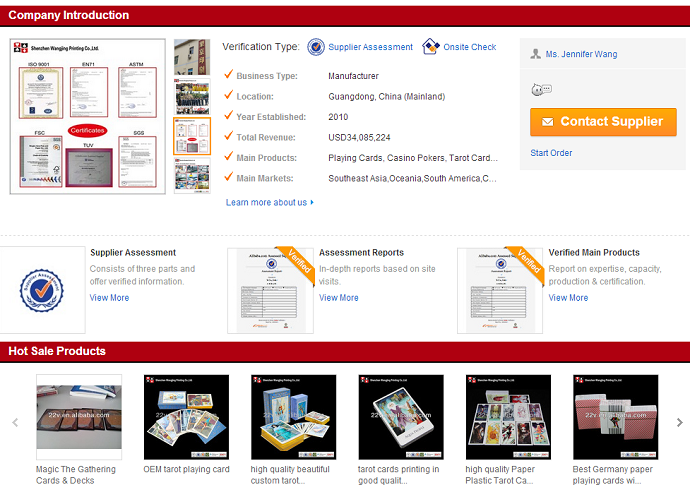
On Friday the link to the page offering Magic card printing was removed from the front page. If you follow the direct link, it will still claim to offer Magic cards for sale, though all images containing Magic cards have been deleted.
The sets are cheap, and they can make a lot of them.
According to the website, each set costs $0.80 each to buy. A set contains 54 to 56 unique cards, which means that someone wanting to deal counterfeit cards can pick that many different Magic cards to work with. 1000 sets is the minimum order, which means you have to spend at least $800. This isn’t a small amount of money, but it’s less than the cost of a single Beta Mox.
For that $800, you get one thousand copies of each card you ordered for a total of about 54,000 cards. These are not small quantities of fakes we’re talking about here. Thousands of fake Tarmogoyfs, Windswept Heaths, and Jaces are probably out there already.
This is not hidden information. It is right out there on the website. This is what was up until last Thursday:
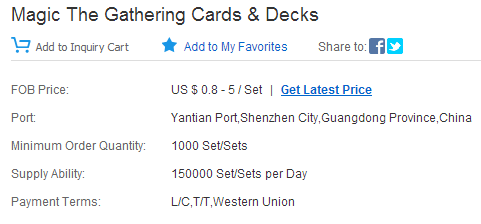

Here’s what they switched it to as of Friday morning:
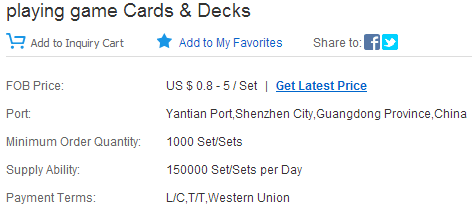
According to this, they can produce 8.1 million cards per day if they want to. That number might be a typo or exaggeration, but even still this isn’t someone’s kiddie printing press we’re talking about. This is a serious operation that could flood the market for any Magic card within hours. Everyone who says that fakes cannot be produced and distributed at a fast enough rate to crash the secondary market needs to rethink their position.
There is a set of 55 fake cards that was offered for sale by that website for international distribution.
It is likely that the current batch of forgeries goes beyond this list, but for now the following cards should be treated with extreme caution:
Standard
- Blood Crypt
- Breeding Pool
- Elspeth, Sun’s Champion
- Godless Shrine
- Hallowed Fountain
- Jace, Architect of Thought
- Kalonian Hydra
- Mutavault
- Nykthos, Shrine to Nyx
- Overgrown Tomb
- Purphoros, God of the Forge
- Ral Zarek
- Sacred Foundry
- Sphinx’s Revelation
- Stomping Ground
- Temple Garden
- Thassa, God of the Sea
- Thoughtseize
- Watery Grave
Modern
- Academy Ruins
- Aether Vial
- Arid Mesa
- Avacyn, Angel of Hope
- Batterskull
- Bonfire of the Damned
- Cavern of Souls
- Celestial Colonnade
- Chalice of the Void
- Elspeth, Knight-Errant
- Engineered Explosives
- Figure of Destiny
- Goblin Guide
- Inkmoth Nexus
- Inquisition of Kozilek
- Iona, Shield of Emeria
- Island (Unhinged)
- It That Betrays
- Karn Liberated
- Kokusho, The Evening Star
- Leyline of Sanctity
- Marsh Flats
- Misty Rainforest
- Mountain (Unhinged)
- Path to Exile
- Plains (Unhinged)
- Reflecting Pool
- Scalding Tarn
- Sensei’s Divining Top
- Snapcaster Mage
- Spellskite
- Stoneforge Mystic
- Sun Titan
- Surgical Extraction
- Swamp (Unhinged)
- Sword of Feast and Famine
- Sword of Fire and Ice
- Sword of War and Peace
- Tarmogoyf
- Verdant Catacombs
Legacy
- Demonic Tutor
- Flooded Strand
- Force of Will
- Goblin Lackey
- Goblin Piledriver
- Intuition
- Pernicious Deed
- Polluted Delta
- Reanimate
- Savannah
- Sol Ring
- Swords to Plowshares
- Tropical Island
- Tundra
- Underground Sea
- Vampiric Tutor
- Wasteland
- Windswept Heath
- Wooded Foothills
This list came from a member of a Facebook group that contacted the above website. I have no idea if they are making more cards than these or if the really insidious fakes are coming from another source entirely. For example, Liliana of the Veil isn’t on this list, but you’ll see a very accurate Liliana forgery further down in this article. It isn’t much to go on, but if you see someone with, say, a large amount of Unglued Plains, Mountains, Swamps, and Islands for trade but no Forests, alarm bells should ring in your brain.
The fakes are very good.
I’m taking this next bit straight from the Polish Tamales blog and a couple of Reddit posts. Here are a few pictures of the cards:
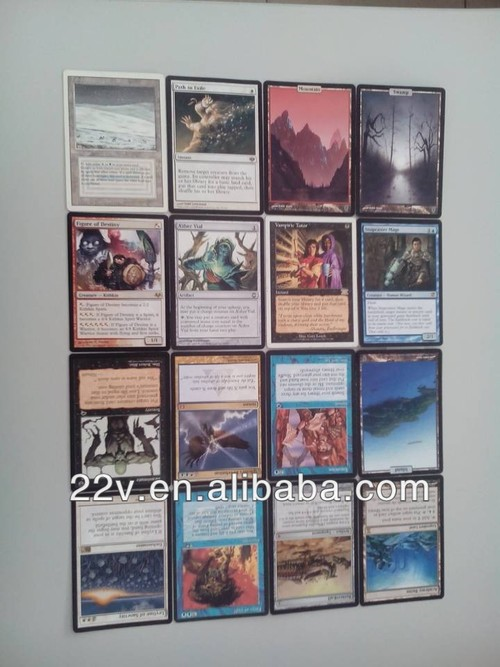
I can’t tell that these cards are fake at this distance. Of course, you could print out pretty much anything and it would be hard to tell in a distant picture over a computer monitor. Even still, it’s kind of disturbing seeing lower-valued cards like Reanimate and Figure of Destiny in here. Who would even think to fake those, right?
From what I’ve been able to ascertain, this counterfeiting ring has been focusing on newer cards. This makes a certain amount of sense; not only is it harder to fake twenty years’ worth of aging on a Mox, but cards of that caliber are held under a lot more scrutiny. Very few people question whether or not their bright new Standard or Modern cards are real.
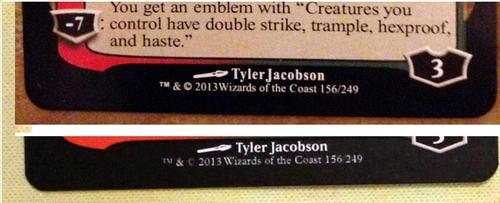
The card on the top is a counterfeit Domri Rade. The card on the bottom is a real one. Note the difference in spacing between the letters in Tyler Jacobson’s name as well as the difference in the trademark and copyright symbols. These are noticeable differences if you’re looking for them and you have something to compare them to, but in a trade binder or an opponent’s deck, you’d never look twice.
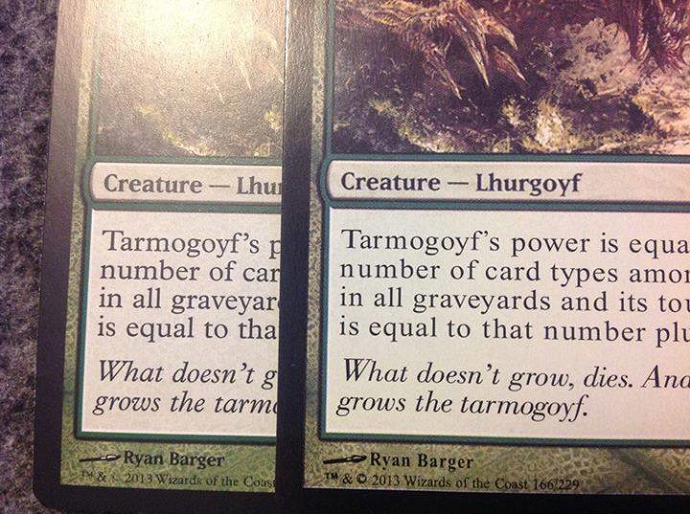
It’s a little easier to tell the fake apart in this picture due to the font spacing. Again, it’s hard to see if you don’t have something to compare it to though.
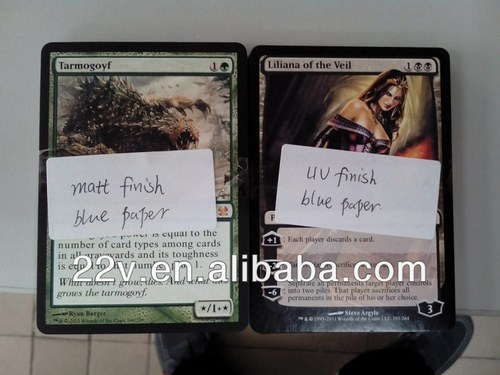
I’m not sure which finish feels more like a real Magic card, but the fact that they’re experimenting with things on this level suggests that things have already progressed past the point of truly obvious fakes. These are next level counterfeits.
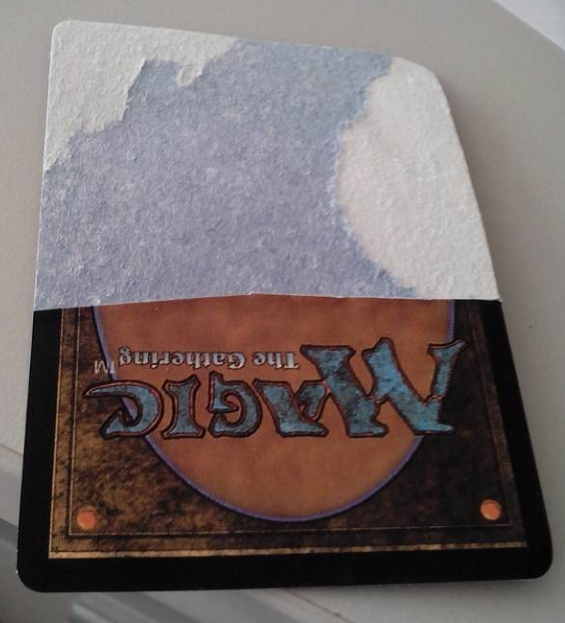
This is the "blue paper" mentioned in the above sales photo. WotC uses a thin layer of blue paper in their printing process, and in the past this has helped forgeries look slightly different and has been a reliable marker of authenticity.
These new fakes use the same (or similar) paper to the one that Wizards uses, which suggests a deeper knowledge of the manufacturing process than in years past. In fact, nearly all anecdotal reports from people who are in possession of these fakes say that they feel just like real Magic cards.
Counterfeit cards are showing up at local stores worldwide.
After letting the world know that I was writing this article on Twitter, I received multiple reports of these fakes being sold at local stores in three different countries, including the US. In Raleigh, NC, there is an ongoing police investigation into this matter and whether or not any of the dealers are complicit. Cards that I have heard have been faked and sold in this way range from dual lands all the way to M14 staples.
As knowledge of the fakes spreads, more and more people may realize that they have recently purchased counterfeit cards without knowing it. If you bought any cards online in recent months, I suggest taking a look at the font spacing and other indicators yourself. It might be too late to get your money back, but it’s not too late to prevent a game loss in your next tournament.
Counterfeit cards are on eBay, and they might be even better than the fakes we know about.
Some people are putting them up for sale as proxies instead of legitimate playsets, but it doesn’t really matter what they’re sold as. Many of the people who buy these are going to slip them right into their trade binders and head for the nearest event. There are also probably plenty of eBay auctions going on right now where counterfeit cards are being sold as legitimate playsets.
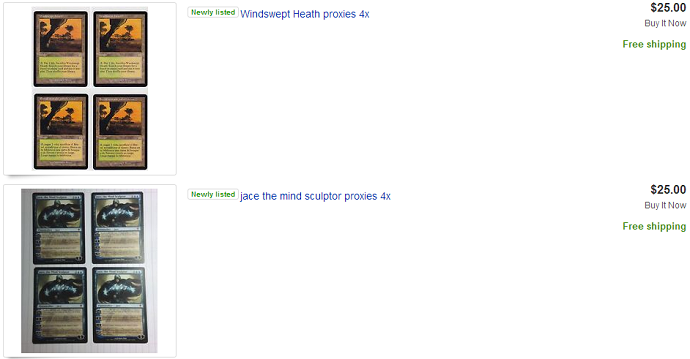
Even scarier, check out this listing of Polluted Delta proxies that just sold for $25:
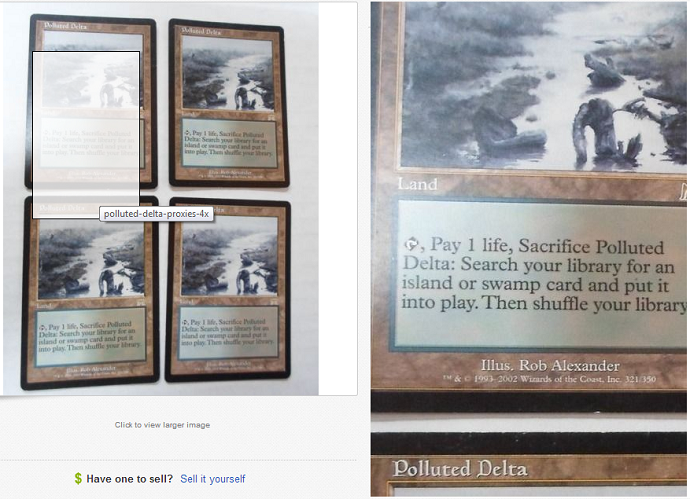
Uh oh. Take a closer look:
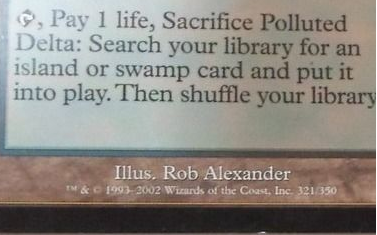
It looks like the correct copyright symbol and font spacing. Here’s a legitimate copy of Polluted Delta:
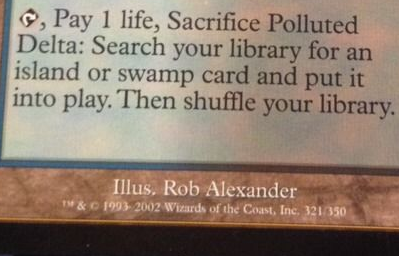
Can you tell the difference? It looks like the font is slightly crisper on the lower card, but it’s very hard to see. I’m not even sure the above copy of Polluted Delta is a fake—perhaps the guy who sold the counterfeit used a picture of the real card in the auction listing.
If it is a fake, though, we might be in really big trouble.
It is likely that the counterfeiters are distributing these cards themselves on the secondary market.
If hiring a Chinese playing card printer to fake Magic cards is so cheap and easy, why hasn’t anyone done it before?
Well, they have—hundreds of times in fact. Fakes have existed in Magic for years and have always been part of the game. WotC has issued a few responses to it over the years, and they take counterfeiting very seriously. It is one of the biggest threats to their brand. I guarantee you that Wizards will take whatever action they can and they’ll do it fast.
Until recently, though, it was fairly easy to tell fake cards and real cards apart. Counterfeits felt wrong to the touch. They were too light or too dark. They didn’t bend correctly and lacked the layer of blue paper. Some power was faked very well, of course, but this was never done in large quantities and most Magic players don’t even think about cards at this level.
I suspect that lower-value cards weren’t faked en masse before because it’s a difficult operation to set up and execute well. First, you’d needed to find a printer in China that doesn’t care about copyright violations and is also willing to experiment with you in order to try and produce a convincing fake, which might take months to perfect. You’d need to be fluent in Chinese and have knowledge of where to go for all the supplies you’d need, enough money to start an operation, and a desire to defraud thousands of peers.
It also requires enough Magic knowledge to know what cards to counterfeit and how best to sell them, which is the real limiting factor. There probably aren’t a lot of people in the world capable of doing all of this. Of those who tried in the past, no one really got it right.
Things are different now, and I suspect that it is because the people printing the cards are part of the Magic secondary market.
This isn’t the case of a random Chinese printer moving in on Magic because they read about it on a blog; this is probably a group of Chinese dealers and internet retailers getting together and deciding to finally do this right. It’s the simplest and best explanation for why the fakes are so good right now.
I have had this suspicion backed up for me from a source that wishes to remain undisclosed, so it isn’t just idle conjecture on my part. While I don’t have enough information to say for certain that this exactly what’s happening, it is very likely that this is the case.
This isn’t completely new either. I’ve been told that these fakes have likely been distributed at US Grand Prix by Chinese dealers and floor traders as early as the summer of 2012 and we just haven’t known about it until now.
I have also been told that there are several generations of fakes out there and that the addition of the blue layer of paper is fairly recent. Some of the earlier fakes aren’t quite the right size and have font issues, but the newest generation is almost perfect. This makes me believe that the problems with the current generation of fakes will be ironed out sooner or later.
Wrong font? Bad spacing? Copyright symbol too bright? The counterfeiters are reading all of this right now and probably working to fix it for their next batch of cards. Before long they should be able to print fakes that are impossible to tell from the real thing without intense scrutiny. As you saw with the Polluted Delta on eBay, it is likely that this has already happened.
The supplier who runs that website claims to have had his Magic: The Gathering operation shut down by police.
On Friday a Magic player who contacted that website about ordering fake cards (presumably to collect information) received the following reply:
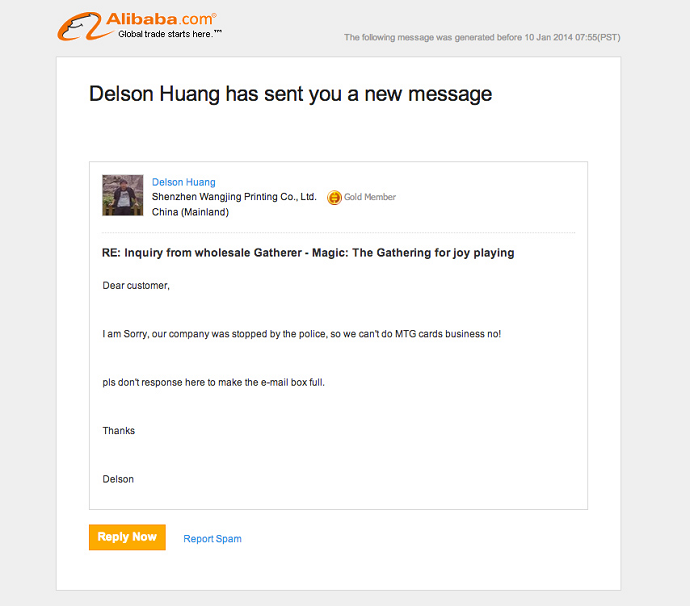
It is possible that this is true and this is the end of it. It is also possible that this is a lie designed to temporarily take the heat off this counterfeiting ring while they rethink their means of distribution. True or not, it certainly does give me hope that my fears are massively overblown.
Where Do We Go From Here?
It is still too early to know what is going to happen and how bad this problem will get. Everything else in this article is reasoned guesswork as I attempt to grapple with the enormity of this problem.
The best-case scenario obviously is that the printer and website are shut down and that they will stay down. Hasbro clearly understands the risks that counterfeiting poses to their business, and I wouldn’t be shocked if they have plenty of connections in China that could help them out quite a bit. This is one of the advantages of the fact that Magic is owned by a huge multinational corporation. They have resources that we do not and cannot know about.
What gives me pause however is that China hasn’t seemed to care much about violating US copyright law in the past. Magic cards have been faked there forever right along with millions of other products. There are counterfeit Coach bags and Oakley sunglasses for sale on every shady street corner in the world. Is Hasbro really more powerful than both of those companies?
I also worry that shutting down the obvious means of distribution isn’t enough. Selling cards en masse on a website is one thing, but if these counterfeiters truly have the means to produce undetectable forgeries and knowledge of the secondary market, they’ll be popping up for sale on eBay and other websites going forward. That trickle will not crash the market overnight, but it will also be much harder for Hasbro to stop.
If the counterfeits keep coming, our judge community will have to bear a heavier burden. Players are going to run these cards in tournaments at all levels, some by accident and some on purpose. According to current penalty guidelines, this is a deck/decklist problem, which means you would have to replace the fake with a legal copy of that card (or basic land) and incur a game loss.
I would bet that at some point in the next few months a high-profile player will lose a high profile match due to a counterfeit card they had no idea about being spotted by a judge.
The judge community is already well aware of the situation of course. This is the current word on it from WotC per Scott Marshall on the judge forums:
Please have persons who note fraud (such as counterfeiting) sites to report them to [email protected].
If a judge in their opinion has a player using counterfeits, they should treat them as a player attempting to use their own proxies and have the player replace them.
Do not attempt to confiscate counterfeits.
If a Wizards of the Coast representative is at the event, please get them involved immediately.
It is not the job of a judge to guess the intent of a player using a counterfeit card. Judges will simply be attempting to spot them and ensure that sanctioned games of Magic are only played using legal cards. It does seem however those Wizards will do their own follow-up investigations if they believe there is more to the situation than a simple mistake.
Level 3 judge Eric Levine also shared with me his own thoughts on the counterfeits from the perspective of an active judge and longtime player. I thought that his words were worth printing here in full:
I caution judges and players alike against being swept up in the frenzy that seems to be going on about this. Freaking out about this, whether in the form of selling out of Legacy; scrutinizing every card with a jeweler’s loupe; or declaring cards "counterfeit" at your events simply because they are misprinted, miscut, or "weird looking," is not the way to do it. Like it or not, counterfeit cards existed before this recent brouhaha, and they will exist after it. If you weren’t being vigilant before, treat this as a wake-up call. Remember, you’re a Magic player. You know what Magic cards look, feel, and read like. If it feels wrong, don’t trade for it. If counterfeits were going to crash the market, I think it would already have happened.
Eric is right. Counterfeiting isn’t new, and for twenty years it’s mostly been a minor problem for us players and traders. With any luck, this situation will blow over as well. If it is at all possible, players will learn how to tell the fake cards apart, and they’ll slowly but surely be removed from circulation. This has happened dozens of times before with other Magic counterfeiting operations, and it should happen again here.
But what if it is different this time? Or next time? What if this counterfeiting ring truly is capable of producing fake Magic cards that are impossible to tell apart from real ones without intense scrutiny? What if the next one is? I don’t think this is too big a leap to make. This is not science fiction. If there is anything proprietary about Wizards’ card production process, I don’t know how to detect it.
Based on what I’ve seen, anyone with the right printer and technology can make functionally identical Magic cards. I would bet that someone out there is doing so right now.
Why Counterfeiting Is Bad
I didn’t think I would need to write this section, but then I went to Reddit.
In the largest thread dedicated to the Chinese forgeries, the top comment is this one:

I have noticed that this is a fairly common reaction to the counterfeiting story, but it is a misguided opinion. If you are a true fan of Magic: The Gathering, you should be unequivocally against counterfeit cards.
Let’s imagine for a moment that the market becomes flooded with really good counterfeits. They are so good that it is impossible to distinguish them from authentic Magic cards. Some of the bigger sites like this one will probably attempt to only sell "authenticated" singles using whatever methods they can to try and sort out the fakes, but the floodgates will open quickly once people realize what’s going on.
The biggest problems will start once judges become unable tell real cards from fake ones in a timely fashion. Most ethical people would try to only play with actual cards, of course, but if it becomes truly impossible to tell them apart in a tournament setting, the lines will start to blur. People will tell themselves that playing with these cards is no different than movie, music, or software piracy. The "Magic player" demographic and the "software pirate" demographic has a lot of overlap, so this won’t be a huge leap for most players.
Even the holdouts and honest players will be forced to conform. If there’s no way of knowing for sure whether a card you buy was actually printed by Wizards or not, it becomes easy for all of us to cross that line and impossible not to.
At that point card prices will be at record lows. If I can have a million Tarmogoyfs printed for me in a single day for $0.015 each—that’s a penny and a half per card, close to what that site charges for fakes right now—why should I ever pay more than that for any card? Cards will cease being worth more than the value of the paper that they’re printed on. After all, what are you paying for when you buy an Underground Sea? Cardboard and faith. Only one of those things will be left standing.
At first this seems like a populist fantasy. Finally dual lands are free from the tyranny of the 1%! We can all play Modern and Legacy to our heart’s content free from the burden of limited print runs, the reserved list, or any WotC control at all! Bring on the revolution!
Here’s the problem. A majority of the infrastructure of the Magic community exists because of the value that cards have on the secondary market. If the collectable aspect of the game disappears, the community will collapse.
Do you like playing Magic at your local store? Chances are that they make a large portion of their revenue from selling singles. If singles become worthless, that part of their business would be gone overnight. Many stores would have to close down on the back of this problem alone. If you think stores make money selling booster boxes, you’ve never checked the margins. Some stores would be able to survive selling snacks and board games, but many would not.
The problem goes further than that though. People buy boxes, packs, event decks, boxed sets, and everything else in part because they know it will retain some of its value on the secondary market. Even if you’re never planning to sell your collection, the fact that you can sell it matters a lot. People justify their Magic purchases based on this. Part of the excitement of opening a pack—even in a draft—is the chance of opening a high-value card.
If cards become worthless, many fewer packs will be opened. After all, why preorder a box of the latest set if you can buy a dozen copies of the entire set from China for a couple of dollars?
This would be almost as catastrophic for WotC as it would be for brick and mortar stores. Magic sets are great right now because Wizards can afford to employ the best and brightest in the industry. If revenues tanked overnight, the current standard of R&D excellence would not be able to continue.
Organized play would also take a huge hit. FNM would survive—but only at stores that make enough of their money on other products to stay open without selling singles. Larger events, like PTQs, Grand Prix, and Pro Tours, would likely have their prize money cut considerably. Organizers would no longer gain much revenue from selling table space to vendors, and the WotC budget for these events would probably result in fewer tournaments for lower prizes. Some pros would stick around and there would still be some grinders, but most of them are barely scraping by as it is and could not deal with many more cuts. We’d certainly lose a large number of the people who make the game special today.
I would also guess that a large saturation of counterfeit cards would cripple the amateur circuit and most professional Magic writing. (I am speaking on my own and not for SCG here. I have no insider knowledge on this topic at all.) Tournament series like the StarCityGames.com Open Series depend on card sale revenue. That money is also what pays for writers like me and everyone else on this site. If these hubs find their main source of income gone, it will be hard to continue supporting a large travelling circus of tournaments. At the very least entry fees would rise considerably and prizes would fall considerably. Fewer people would play. Many would move on to other better-supported games.
So yeah, if counterfeit cards flooded the market, you could play Legacy for free with fake cards—on your kitchen table with some friends. You can already do that with a stack of basic lands and a marker.
Good luck finding a tournament to play in though.
Possible WotC Responses If Things Get Really Bad
In my World War M article, the WotC response to counterfeiting was to reboot the entire game with new cards that would be nearly impossible to fake. Wizards has already taken one step in this direction, introducing a new card face starting in M15 that will contain a proprietary font and foiled bubble that should help stem the tide of fakes going forward.
This would not be enough if a counterfeiting ring began flooding the market with indistinguishable fakes.
The first problem of course is that Magic relies on twenty years’ worth of cards. Even if the new stuff is impossible to counterfeit, every format (including Standard though September of 2015) would be majorly affected by forgeries.
The second problem is that consumer faith in Wizards would be majorly shaken should twenty years’ worth of cards suddenly become worthless. Sure, the new font and foil bubble work now, but what’s to stop the next generation of counterfeiters from faking those too? Even if those two things are foolproof safeguards—something I doubt—people would have a hard time believing that if their collections all go to zero. They won’t stick around for the second crash.
Some have clamored for the discovery of this counterfeiting ring to lead to the elimination of the reserved list and Wizards pumping out a pile of dual lands immediately. I don’t see how that would help. It would be like burning down the bank because there are burglars inside. By flooding the market themselves, Wizards would only lower consumer confidence and dilute their brand even further.
I am for the abolishment of the reserve list—but not as a panicked response to a very real threat.
One option Wizards may consider if things really get bad is some sort of trade-in program. Send in your older cards and they’ll mail you back brand new authenticated cards with the new copy protection on them. At that point they could require all sanctioned tournaments to be played with cards that had the new face.
This isn’t very feasible though. It would require a massive and expensive printing effort on their part, not to mention the hiring of hundreds of people to sort through the submissions and mail millions upon millions of cards. They’d also have to keep the program open long enough to give everyone a chance to do it, which means people could just send them fakes right now and get real cards back in return. It would also cause chaos for people who didn’t want to give up their older cards, perhaps because of collector and sentimental reasons. It would also be very unpopular with people who own lots of foils or altered cards. This plan would be expensive, unpopular, and ineffective.
What about offering trade-ins to Magic Online? Mail in your cards and get their digital equivalences added to your account. This might work, but it still contains many of the problems that the plan above has, with the exception of the added printing costs. Also, Magic Online has shown itself to be completely incapable of handling a burden like this in the best of times. WotC abandoning the paper space entirely right now would be a disaster. In five or ten years, however, this may end up being the way forward.
There may be no good answer here. If super realistic fakes are out there now and there truly is no way to tell them apart, Wizards could be facing down a Kobayashi Maru.
If the market did become flooded with fakes, the only reasonable response would be what I outlined in World War M: moving toward a date in the future when the only cards that could be played in tournaments have the new copy-proof card face. This would likely require a couple years of widely printed Modern and Legacy Masters sets, and yes, the reserved list would have to go. (Or Wizards would have to stop supporting Legacy entirely and only salvage Modern.)
This plan would work, but the chaos it would cause would cripple Magic in the short term.
Conclusions
It’s hard to counterfeit money. Governments use special blends of rag paper and devote massive amounts of resources into staying one step ahead of criminal technology. Even still, people do it.
It’s hard to counterfeit older collectables like rare baseball cards, comic books, and vintage action figures. Most of these things are at least thirty years old and require forgers to get thousands of tiny details exactly right. People still do it.
It’s relatively easy to counterfeit Magic cards. There’s nothing proprietary about them, and they aren’t old enough to make it impossible to tell the new fakes apart. Most gamers aren’t used to looking for fakes, either, so they’ll eagerly lay out a couple hundred dollars for a few pieces of cardboard that could have come from anywhere. Based on the current Magic economy, I cannot name a single thing in the entire world that is as easy to counterfeit as a Magic card that would provide a higher rate of return.
Think a total market crash is impossible and that I’m waving a doomsday flag for no reason? This dilemma is not that much different than what happened to the music industry in the late 90s or the film and TV industry right now. As it gets easier and easier to get ahold of versatile printing technology, Hasbro will have to keep trying to stem the tide on all fronts. It will not be easy for them.
So yes, things look bad. If that Polluted Delta fake is real, we’re especially in trouble. This isn’t the end of Magic, though, even if Hasbro can’t stop the fakes. And honestly, I have faith that they they’ll find a way if they haven’t already.
In situations like this, it’s important to take a deep breath and think logically. This is what I recommend for now:
– Do not sell your entire Magic collection. With the fakes on the market, it’s going to look suspicious and won’t gain you full value anyway. Also, you know that your cards are real and that might end up mattering at some point. Plus, you still like playing Magic, right? You can still do that! And if this latest round of counterfeiting fear blows over quickly, you’ll be kicking yourself for jumping the gun.
– If you have copies of the Power Nine in good shape and you aren’t actively playing Vintage, consider getting them graded. This proves authenticity.
– If you’re worried about fakes, Alpha cards, foils, foreign cards, and older stuff are a better place to be than Modern or Standard right now. These things are harder to fake and easier to authenticate. There will always be people finding ways to tell a real Black Lotus from a fake one because the real one has so much collector value. There might not be an easy way to tell a fake Liliana from a real copy, and there’s not as much incentive for someone to offer that service. It seems counterintuitive, but your older and more valuable cards are safer than your cheaper and newer ones right now.
– If a deal is too good to be true, it probably is. Don’t buy that playset of Polluted Deltas for $50 from that sketchy eBay auction or weird website. Right now I’m only going to trade with people I trust online and at my local shop. I’m only going to buy from retailers I trust to screen for counterfeit cards.
– Learn how to spot the current generation of fakes. Check your recent acquisitions and make sure you don’t have any already. Print out a copy of that Domri Rade comparison and tape it to the inside of your trade binder or keep it on your smart phone.
– Do not buy counterfeit cards deliberately for any reason. I do not care if you want them for a kitchen table game or what. If there’s no money in it, fewer of these will show up to pollute our stores, and there’s a chance that the counterfeiters will stop innovating and move on to something else.
– If you have any concrete information about people making counterfeit cards, please go to the police or contact Wizards of the Coast directly.
The best thing you can do is to remain emotionally positive while logically preparing for the worst. Panic doesn’t help. Burning down the game doesn’t help. We need to stick together as a community, stand against these forgeries, and count on Wizards to find a solution. They’ve never let us down before, and I don’t think they’ll let us down now.
This Week’s Trends
All of these price predictions don’t factor in any possible market drop due to the counterfeit cards.
– Genesis Wave jumped from $3 to $7 thanks to a couple of interesting Modern decks. It’s a great casual card too, so I think the price will stay elevated for a while.
– Apocalypse Hydra is the latest random casual monster to start trending toward $10. Keep an eye out for undervalued copies in binders.
– We will be getting a Modern Event Deck in May. There will probably only be one, and it will retail for $75. The only clue we have right now is that it contains five double-sided tokens. I have no idea what deck it might contain, but it will likely cause a number of Modern staples to drop in value. I expect it will sell out quickly in most places, but it probably won’t be as limited as something like Commander’s Arsenal. Overall, I would not think much more about it until we have a list.
– Kami of the Crescent Moon was hyped up a few weeks ago, but the buyout has continued. Good luck finding a sub $5 copy now. I blame Nekusar and also the nebulous buyout brigade.
– Wizards is printing a limited number of square silver coins in New Zealand that have Jace’s picture on them. This is a very silly thing, and is the sort of useless manufactured collector’s item that I hate investing in. Stay away unless you want one for yourself.
– Summoner’s Egg made a random detour to $8 thanks to Travis Woo revealing that he’s messing around with it in Modern. Sub-$1 copies have started to reappear, but there are only a few. Through the Breach, also in Travis’ deck, has begun to spike a bit too. This deck will have to prove itself more before these prices stabilize above their current levels though.
– There has been a slow and steady Birthing Pod buyout going on. Finding a copy under $9 has gotten kind of hard, and most stores are buying at $4. This is just standard Modern speculation, and I’ve long called this a $12-$15 card.
I’ll keep you updated on the situation in this column as much as I can as well as on Twitter.
